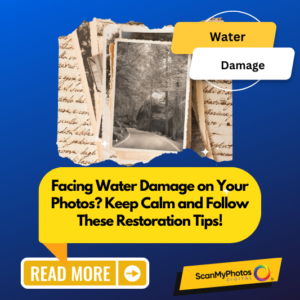Water Damage? Don’t Panic!
Facing Water Damage on Your Photos? Keep Calm and Follow These Restoration Tips!
 Water damage is a common and distressing issue that plagues countless cherished photographs. Whether it’s the result of humidity, hurricanes, or more severe water exposure, such situations often lead people to seek the services of photo restoration experts. However, it’s always preferable to prevent water damage to your family photos in the first place. The critical takeaway is to plan ahead. Be prepared and digitize all your photos, slides, film negatives, and reels of home movies before a weather event threatens your irreplaceable pictures.
Water damage is a common and distressing issue that plagues countless cherished photographs. Whether it’s the result of humidity, hurricanes, or more severe water exposure, such situations often lead people to seek the services of photo restoration experts. However, it’s always preferable to prevent water damage to your family photos in the first place. The critical takeaway is to plan ahead. Be prepared and digitize all your photos, slides, film negatives, and reels of home movies before a weather event threatens your irreplaceable pictures.
<< How to digitize pictures >>
If your home has experienced a flood or fire, chances are your treasured photographs have been affected by water damage. The first piece of advice when dealing with water-damaged photos is: Don’t Panic! There’s a good chance you can salvage many, if not all, of your pictures.
The Associated Press (AP) just reported on the emotions and urgency of digitizing your archives of photo memories. Each person profiled had ScanMyPhotos digitize their slides and pictures. Link to the article published in 400+ media outlets: “Millions of old printed photos are in storage. Digitizing them can unlock countless memories.”
While you might want to consider reaching out to a photo conservation professional or consulting relevant literature, here are some initial tips to help you navigate this challenging situation:
- Prevent Drying Out: Do not allow your photos to dry out naturally. As they dry, they can adhere to each other and any adjacent materials, making it nearly impossible to separate them without causing potentially irreparable harm.
- Act Swiftly: Your photographs should remain wet for two or three days. It’s advisable to have a friend or a photo restoration expert scan the images before attempting any separation or actions that could further harm them.
- Use Cold Water: While working on your photos, keep them in a cold, clean tap water container. The colder, the better. Avoid adding chlorine to the water, but remember to change it daily. Chlorine from tap water is sufficient to prevent the growth of fungi and other biological threats.
AccuWeather: Why it’s important to protect your cherished, irreplaceable photos before a natural disaster happens.
- Gentle Rinsing: Carefully rinse your photos in a cold, clear, running water container. Avoid running water directly onto the photos, as this could damage the chemical emulsion, resulting in permanent harm. Continue rinsing until the runoff water becomes clear.
- Separate with Caution: Carefully remove your photographs or negatives from the water, taking the smallest quantity possible. Gently separate them without forcing them apart – forcing can lead to additional damage. Separate as many as possible before returning them to the cold water to work on another batch. Repeat this separate-and-soak cycle as necessary. Sometimes, you may have to accept some associated damage if separation proves impossible.
- Individual Cleaning: Once materials are separated, keep them in water until you can wash them individually using cold, clean running water. Use cotton balls, a soft cotton cloth, or a soft foam rubber brush to remove foreign objects. Rinse your photographs or negatives one more time after cleaning is complete.
- Proper Drying: Hang-dry prints and negatives from a clothesline while ensuring they remain dust-free. Unique solutions are available for uniform, spot-free drying when applied to negatives and slides.
- Addressing Curled Prints: If your prints curl during drying, wet the paper side (NOT the emulsion) with a moist sponge. Then, sandwich each print between two pieces of acid-free paper or photo blotters and place them under a flat, heavy object for a day or two.
Remember, with patience and care, you can often rescue water-damaged photos and preserve the precious memories they hold.
<< Photo restoration services >>



